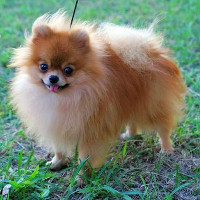Appearance of the Paperanian
|
| The mixture of Papillon and Pomeranian has given birth to a new breed whose appearance can vary somewhat from litter to litter. No matter which parent it takes after the most. the Paperanian will inevitably be small and delicate with a good amount of plush fur and a tail that curves elegantly over the back. With a slim, graceful, compact body and slender limbs, this dog was built to sit on laps rather than pull loads or hunt for hours in the field. The Paperanian's head is delicate, with a rounded skull. The breed's medium-sized, triangular ears stand upright and are fringed with silky fur. Paperanians have alert, expressive brown eyes and a small black nose. The Paperanian's coat varies, but is generally medium to long and fairly dense. Dogs can be black, white, fawn or brown, and some individuals are bicolored. A small dog, the Paperanian is a toy breed that weighs between 2 and 5 kg and measures between 18 and 30 cm at the withers when fully grown. |
Temperament of the Paperanian
|
| Gentle and affectionate, Paperanians like to be social and will rarely be happy when away from their family. Loyal and gentle, they form close bonds with their owners and can often complain on their behalf when separated. Good with people of all ages, this breed loves to play with children and will do as much harm as any other dog. Likewise, most pedigree dogs will enjoy the company of other animals, including other dogs. Enthusiastic about life, you'll rarely notice the racket or snarling of Paperanians. Not suited to being a guard dog, Paperanians are quite tolerant of new people when well socialized, and are not hostile or territorial enough to defend their family. Although it may bark in the direction of an intruder, it will rarely do much more. |
Needs and activities of the Paperanian
|
| The Paperanian hybrid, a Papillon/Pomeranian mix, is a dog with a modest amount of energy to expend on a daily basis. He'll love going for long walks or jogs with you and, if you're a busy person, and he's small, these long walks only last 20 to 30 minutes. Giving him a moderate amount of playtime at home with his favorite toys or spending time outside on a leash in a fenced or similarly enclosed area will help him manage his energy levels. Because he's small and not overly active, he'll live very well in an apartment or family home with or without a fenced yard, provided the commitment to proper exercise is maintained. They can live in urban or rural environments, and tolerate moderate climates, neither too hot nor too cold, unless appropriate extra protection is provided. |
Maintenance of the Paperanian
|
| The Paperanian Papillon/Pomeranian hybrid is a dog that will require moderate maintenance. As you'd expect from a longer-haired dog, brushing is necessary two or three times a week to remove dead hairs, mats and tangles. Shampoo every two or three weeks to keep the coat clean and shiny. After bathing, be sure to wrap your four-legged family member in a towel to keep the fur as dry as possible. This hybrid is a low-loss animal and is considered hypoallergenic. Therefore, when bathing your dog, you should use a mild shampoo for hypoallergenic dogs. Weekly attention should be paid to the ears and nails of this hybrid, cleaning the ears with a cotton ball and an approved ear-cleaning solution, and trimming the nails as required. Teeth should be brushed twice a week to prevent bad dog breath, periodontal disease and tooth loss. |









 English (United Kingdom)
English (United Kingdom)